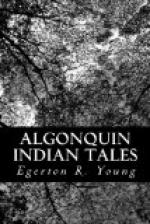“Thus freed from his tormentors, he very rapidly grew up to manhood and became a great hunter, and was kind to his grandmother as long as she lived.”
CHAPTER VI.
Souwanas Tells of the Origin and Queer Doings of Nanahboozhoo—How He Lost His Brother Nahpootee, the Wolf—Why the Kingfisher Wears a White Collar.
“Who was this Nanahboozhoo that we are hearing so much about?”
Thus was the old story-teller addressed by Sagastao, who always was anxious to learn about those who interested him.
The old man began in this way:
“When the great mountains are wrapped in the clouds we do not see them very well. So it is with Nanahboozhoo. The long years that have passed since he lived have, like the fogs and mists, made it less easy to say exactly who he really was, but I will try to tell you. Nanahboozhoo was not from one tribe only, but from all the Indians. Hence it is that his very name is so different.
“The Ojibway call him Mishawabus—Great Rabbit; the Menomini call him Manabush. He had other names also. One tribe called him Jouskeha, another Messou, another Manabozho, and another Hiawatha. His father was Mudjekeewis, the West Wind. There was an old woman named Nokomis, the granddaughter of the moon, who had a daughter whose name was Wenonah. She was the mother of twin boys, but at their birth she died and so did one of the boys. Nokomis wrapped the living child in soft dry grass, laid it on the ground at one end of her wigwam, and placed over it a great wooden bowl to protect it from harm. Then in her grief she took up the body of Wenonah, her daughter, and buried it, with the dead child, at some distance from her wigwam. When she returned from thus laying away her dead she sat down in her wigwam, and for four days mourned her loss. At the end of that time she heard a slight noise in her wigwam, which she soon found came from that wooden bowl. Then as the bowl moved she suddenly remembered the living child, which she had forgotten in her great grief at the loss of its mother. When she removed the bowl from its place, instead of there being the baby boy she had placed there she beheld a little white rabbit, and on taking it up she said, ‘O my dear little rabbit, my Manabush!’ Nokomis took great care of it and it grew very rapidly.
“One day, when Manabush was quite large, it sat up on its haunches and hopped slowly across the floor of the wigwam, and caused the earth to tremble.
“When the bad Windegoos, or evil spirits who dwell underground, felt the earth to thus tremble they said, ’What is the matter? What has happened? A great Munedoo (spirit) is born somewhere.’ And at once they began to devise means by which they might kill Manabush, or Nanahboozhoo, as he was now called, when they should find him.




